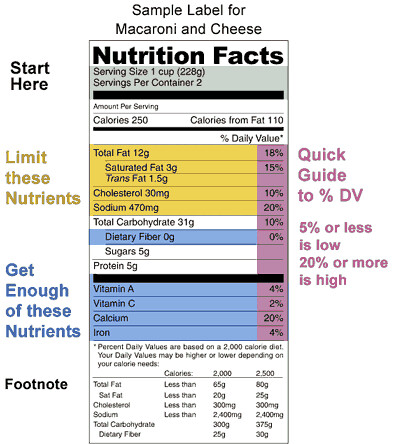Sometimes, maybe we are just expecting too much of people. Over the past years, food nutrition labeling has become all the rage and research has put great emphasis on the question whether food labeling (especially related to caloric and fat content) makes a difference in purchasing decisions. The results are mixed, with some studies finding (small) significant changes in consumption choices after exposure to nutrition labels and others arriving at more modest conclusions. Overall, it seems as if the introduction of nutrition labels (in the 90s in the US example) has not brought about a sudden switch to a healthier lifestyle for most.

Image by SU Professional and Technical Writing, via Flickr CC.
But does that mean that food nutrition labels are generally rather limited in their usefulness, or could we actually keep the concept and just improve on its implementation?
The great people at Upworthy recently reposted a side-by-side comparison of the current US Nutrition Facts label (which is uniform and governmentally overseen) and a modified version. The comparison comes from a “Nutrition Action Healthletter” published in 2009 by the Center for Science in the Public Interest. It is great to have the visual effect, so I would encourage you to head over to their infographic, but for brevity’s sake here are some of the main conclusions:
- Calories and serving sizes should be in larger type.
- the “% Daily Value” should be renamed “% Daily Amount” and include values for transfats, added sugar, protein, etc.
- The daily amount for sodium is currently much too high (at 2,400 mg) and should be lowered to 1,500 mg.
- Color-coding (in red) high values of fat, transfat, added sugars or cholesterol would be a visual aid to those who seek to pursue a healthier lifestyle.
- Caffeine content and the percentage of whole grains (if the product contains any grains) would be necessary to be disclosed on any applicable product.
- Major ingredient groups should be combined, summed and then ordered by percentage content, so that it is easier to discern whether for example sugars or fats constitute a main ingredient of the product.
- Some unnecessary information should be omitted and the all-caps font changed to lower-case to make it easier to read.
It is astonishing to see what a difference such a (slight) facelift makes in terms of ease of use and access. Try out yourself which label you would prefer! And the easier to use and understand, the more I believe such labels could actually impact people’s behavior – if we just began to consider that things need to be made as easy and straight-forward as possible for people to actually start using it.
Bonus: Another perspective is offered by this article, which reports on an experiment where some people were given menus with caloric information, whereas others got references to how long it would take to walk off the calories of a certain menu item. The researchers then tested which group was more likely to go for healthy options and which one opted for the not-so-healthy classics.
Their result: the group that got caloric information behaved no different in their food orders than a control group that had been given no information whatsoever. However, the group with the walking times “ordered fewer of the burgers, fries, chicken tenders, salad, dessert, sodas and water on the menu. They ordered less food, and ate less, too.”
Apparently the visualization of the consequences of ordering that burger really made a difference for many of the test subjects. This is so fascinating because it shows that however much information we add on to the information overload the consumer is already faced with, we might not get anywhere before we change the fundamental knowledge base about nutrition and weight management.
Do you use nutrition labels? Do you have any criticisms on how to make them more consumer-friendly?